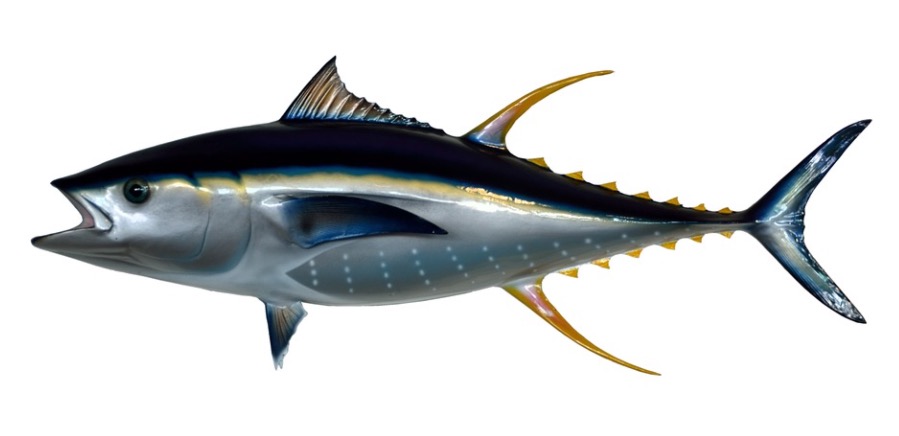Table of Contents
Yellow Fin Tuna: All You Need To Know
Yellow fin tuna is the largest tuna, which resides in the tropical and subtropical waters. The tuna weighs around 180kg and belongs to the kingdom Animalia, class Actinopterygii, family Scomridae and phylum Chordata.
The tuna fish lives for about 6-7 years. This tuna fish due to commercial and sport activities is at the verge of being extinct. It consumes fishes, squids and crustaceans. This fish does not stay in deep water and is found on the surface of water. In Hawaii, its known as “Ahi”.

Yellow Fin Tuna Description
In height this fishes grow about 2.4metres in length and has a weight of 80kg. Thus, its larger than the albacore tuna and tinier than the bluefin tuna. As these fishes have yellow colored dorsal and anal fins, they are called as yellow fin tuna. In adults, these fins change to a sickle shape at the posterior. The fins are long and yellow in color and the body is in dark color, like silver or metallic blue.
Yellow Fin Tuna Habitat and Distribution
Yellow fin tuna is found at the surface of water and at shore at times. Yellow fin tuna are found at Pacific, Maldives, Caribbean underwater and islands are the places where they hunt their prey by luring them. These fish’s travels in herds and may sometimes separate from debris and waste.
Yellow Fin Tuna Diet and Predators
For hunting purpose, they use their muscular bodies to attack a prey such as a baitfish, mackerel and flying fish. Other than that they also consume squid, crustaceans during the night time as they move from depth to the surface water.
The predators of yellow fin tuna are those fishes, which are larger than them. It consists of sharks, seabirds, toothed whales, marlins, false killer whales are the animals which are a threat to the yellowfins. However, they majorly impacted due to the modern industrial species.
Yellow Fin Tuna Reproduction
Yellow fin tuna are said to be as spawners, because the females liberate huge number of eggs in millions in water and many times a year. External fertilization takes place, where male liberates sperms and embryo is formed which swims in the water column as zooplankton community and further forms a larvae and then into a juvenile tuna, which can capture prey now.
Yellow fin tuna lives for a period of 6-7 years and grows rapidly. After a period of 2-3 years, they can sexually reproduce. As Yellow fin tuna are been hunted due to modern type of fishing, which has a effect on the number of tuna fishes and are categorized as Near Threatened on the IUCN red list of endangered species.
Fun Facts About Yellow Fin Tuna!
Yellow fin tuna is a nimble, insatiable and excellent predator with various interesting evidences about it.
a) Warm blooded: Yellow fin tuna are warm blooded, which results in quick movement of strong muscle so that they can run from the hunter or prey on them. As their blood is warm blooded, they can thrive in cold conditions. Thus, being beneficial while feeding in the temperate waters. From the current work, it is said that as waters heats up due to climate change, its less beneficial to the fishes like tuna.
b) Great travellers: Yellow fin tuna are fabulous swimmers and can swim huge distance. The weight of the water is balanced by the fins, which ensures that they can move rapidly and pass-through complete ocean, during their life span. Similar type of fishes are seen throughout the ocean and thus, management and fish conservation requires unity internationally and cooperation among, which is difficult to obtain.
c) Beneath the surface: Usually most of the tuna species, are seen below the water, however, tuna fish resides on the surface of water, from the surface at a distance of 330 feet and can go deep up to 3000 feet. Thus, they may be coming to the surface for obtaining food, temperature regulation and others.
Yellow Fin Tuna Citations
- Mercury in fish products: what’s the best for consumers between bluefin tuna and yellowfin tuna? Nat Prod Res . 2018 Feb;32(4):457-462.
- Heavy metals in yellowfin tuna (Thunnus albacares) and common dolphinfish (Coryphaena hippurus) landed on the Ecuadorian coast. Sci Total Environ . 2016 Jan 15;541:149-154.
- Mercury levels of yellowfin tuna (Thunnus albacares) are associated with capture location. Environ Pollut . 2017 Oct;229:87-93.







